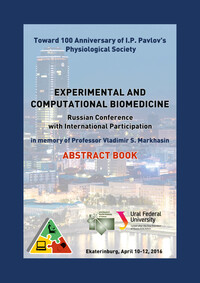Experimental and Computafional biomedicine
Russian Conference with International Participation in memory of Professor Vladimir S. Markhasi
Покупка
Издательство:
Издательство Уральского университета
Год издания: 2016
Кол-во страниц: 82
Дополнительно
Вид издания:
Сборник
Уровень образования:
ВО - Магистратура
ISBN: 978-5-7996-1739-4
Артикул: 798374.01.99
Сборник содержит тезисы докладов, представленных на российской конференции с международным участием «Экспериментальная и компьютерная биомедицина», посвященной памяти члена‐корреспондента РАН В. С. Мархасина (г. Екатеринбург, 10‒12 апреля 2016 г.). Основной целью конференции является обсуждение современного состояния экспериментальных и теоретических исследований в области биомедицины.
Сборник предназначен для ученых, преподавателей, студентов и аспирантов биологического и медицинского профиля.
The volume contains the presentations that were made during Russian conference with international participation "Experimental and Computational Biomedicine" dedicated to corresponding member of RAS V.S. Markhasin (Ekaterinburg, April 10‒12, 2016). The main purpose of the conference is the discussion of the current state of experimental and theoretical research in biomedicine. For a wide range of scientists, as well as for lecturers, students of the biological and
medical high schools.
Тематика:
ББК:
УДК:
ОКСО:
- ВО - Бакалавриат
- 34.03.01: Сестринское дело
- ВО - Магистратура
- 06.04.01: Биология
- 32.04.01: Общественное здравоохранение
- ВО - Специалитет
- 30.05.01: Медицинская биохимия
- 30.05.02: Медицинская биофизика
- 30.05.03: Медицинская кибернетика
- 31.05.01: Лечебное дело
- 31.05.02: Педиатрия
- 31.05.03: Стоматология
- 32.05.01: Медико-профилактическое дело
- 33.05.01: Фармация
ГРНТИ:
Скопировать запись
Фрагмент текстового слоя документа размещен для индексирующих роботов
Министерство образования
и науки Российской Федерации
Уральский федеральный
университет
имени первого Президента
России Б. Н. Ельцина
EXPERIMENTAL
AND COMPUTATIONAL
BIOMEDICINE
Russian Conference with
International Participation
in memory of Professor
Vladimir S. Markhasin
Научное издание
Екатеринбург
Издательство
Уральского университета
2016
УДК 612.089(063)
ББК 51я43
Е97
Все права на размножение и распространение
в любой форме остаются за разработчиком.
EXPERIMENTAL AND COMPUTATIONAL BIOMEDICINE : Russian
Conference with International Participation in memory of Professor
Vladimir S. Markhasin [Электронный ресурс]. – Екатеринбург :
Изд‐во Урал. ун‐та, 2016.
ISBN 978‐5‐7996‐1739‐4
Сборник содержит тезисы докладов, представленных на российской конферен‐
ции с международным участием «Экспериментальная и компьютерная биомедици‐
на», посвященной памяти члена‐корреспондента РАН В. С. Мархасина (г. Екатерин‐
бург, 10‒12 апреля 2016 г.). Основной целью конференции является обсуждение
современного состояния экспериментальных и теоретических исследований в обла‐
сти биомедицины.
Сборник предназначен для ученых, преподавателей, студентов и аспирантов
биологического и медицинского профиля.
The volume contains the presentations that were made during Russian conference
with international participation "Experimental and Computational Biomedicine" dedicated
to corresponding member of RAS V.S. Markhasin (Ekaterinburg, April 10‒12, 2016). The
main purpose of the conference is the discussion of the current state of experimental and
theoretical research in biomedicine.
For a wide range of scientists, as well as for lecturers, students of the biological and
medical high schools.
УДК 612.089(063)
ББК 51я43
Электронное научное издание
Формат 60 × 84 1/8. Гарнитура Calibri. Усл. печ. л. 9,0.
Издательство Уральского университета
620000, Екатеринбург, ул. Тургенева, 4
Тел.: +7 (343) 350‐56‐64, 350‐90‐13
Факс: +7 (343) 358‐93‐06
E‐mail: press‐urfu@mail.ru
ISBN 978‐5‐7996‐1739‐4
© Уральский федеральный университет, 2016
Contents Plenary lectures ................................................................................................ 10 Experimental and computational models in cardiovascular physiology and cardiology ........................................................................................................ 15 Biomechanics. Experimental and mathematical models ................................... 30 Electrophysiology. Experimental and computational models. Clinical studies .. 40 Experimental and computational models in immunology ................................. 45 Molecular basis of biological motility ............................................................... 49 Medical bioinformatics ..................................................................................... 54 Translational medicine. From basic science to clinical practice ......................... 58 Medical chemistry ............................................................................................ 64 Biomedical technology ..................................................................................... 69 Author index .................................................................................................... 75


